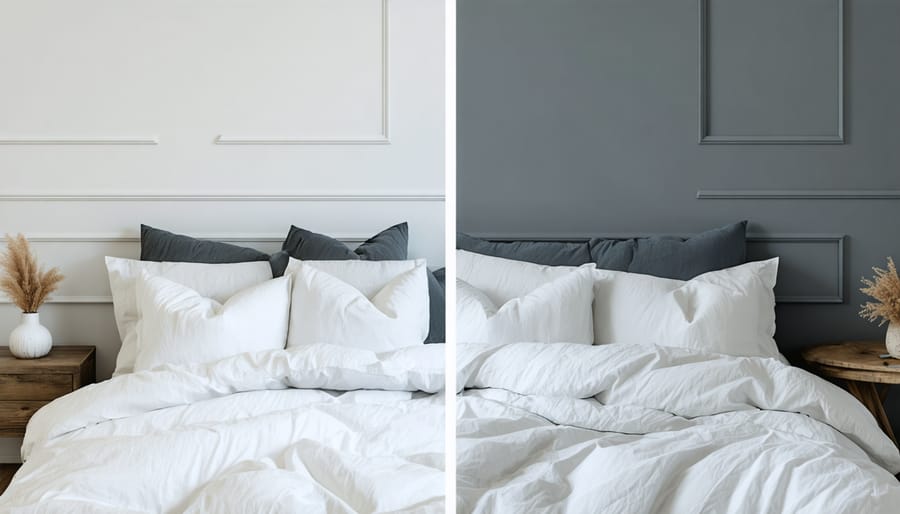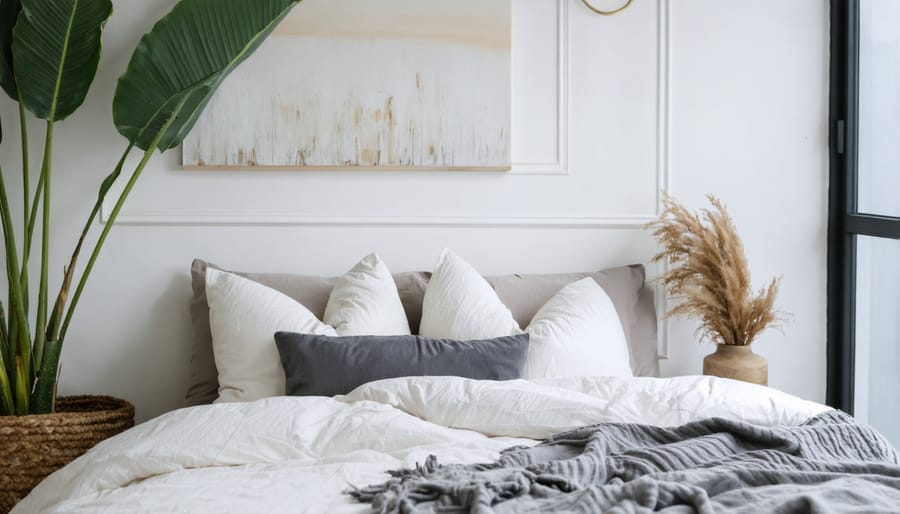Control your bedroom temperature between 18-20°C (65-68°F) to optimize your sleep cycle and boost melatonin production. Your body’s core temperature naturally drops by about 1°C during the night, triggering deep, restorative sleep phases essential for physical and mental recovery. Creating the right thermal environment dramatically impacts sleep quality, affecting everything from how quickly you fall asleep to how long you stay in crucial deep sleep stages.
Install blackout curtains, use breathable bedding materials, and consider a programmable thermostat to maintain consistent temperatures throughout the night. These environmental adjustments work with your body’s natural thermoregulation system, which operates on a 24-hour circadian rhythm. Understanding and optimizing your sleep temperature isn’t just about comfort—it’s a fundamental aspect of sleep hygiene that can transform your rest quality and overall health.
The Science of Sleep Temperature
Your Body’s Natural Temperature Rhythm
Your body maintains a natural 24-hour temperature cycle that’s closely tied to your sleep-wake patterns. This cycle, part of your biological clock, helps regulate when you feel alert and when you feel sleepy. Throughout the day, your core body temperature fluctuates by about 1°C, reaching its peak in the late afternoon and its lowest point in the early morning hours, typically between 2:00 and 4:00 AM.
As evening approaches, your body temperature naturally begins to drop, triggering the release of melatonin, the sleep hormone. This cooling process is essential for initiating and maintaining quality sleep. During the night, your body temperature continues to decrease gradually, helping you stay asleep. The coolest point of your body temperature coincides with your deepest sleep phase.
Towards morning, your body temperature slowly rises again, preparing you for awakening. This natural warming acts as part of your body’s wake-up signal, along with increasing cortisol levels and declining melatonin. Understanding this natural rhythm can help you optimize your sleep environment and timing to work with, rather than against, your body’s natural temperature regulation system.

The Ideal Sleep Temperature Range
Research shows that maintaining the right bedroom temperature is crucial for optimal sleep quality. The ideal bedroom temperature typically falls between 18°C and 21°C (65°F to 70°F). This range helps your body naturally lower its core temperature, which is essential for initiating and maintaining sleep.
Your body temperature naturally drops by about 0.5°C to 1°C during sleep, and a cool environment supports this process. However, personal comfort varies – factors like bedding thickness, sleepwear, and individual preferences can affect your ideal temperature. Older adults and young children might prefer slightly warmer temperatures, while athletes and those who run hot might benefit from the cooler end of the range.
To maintain this ideal range year-round, consider using programmable thermostats, appropriate bedding layers, and seasonal adjustments to your sleep environment.
Temperature Regulation Strategies for Better Sleep
Bedroom Environment Control
Creating the ideal bedroom environment is essential for maintaining optimal sleep temperature throughout the night. Start by setting your thermostat between 18-20°C (65-68°F), which research shows is the ideal range for most people. During warmer months, use a combination of proper ventilation and cooling strategies to maintain this temperature.
Install blackout curtains or shades to prevent heat gain during summer days, and consider using a ceiling fan to improve air circulation without dramatically lowering the temperature. In winter, ensure your bedroom is well-insulated to prevent cold drafts while maintaining proper ventilation.
Humidity also plays a crucial role in sleep comfort. Keep bedroom humidity levels between 30-50% using a humidifier in dry winter months or a dehumidifier during humid summers. This range helps prevent sleep disruptions from dry air or excessive moisture.
Consider using breathable bedding materials that help regulate temperature, and ensure proper air circulation by keeping vents unblocked and doors slightly open. Regular maintenance of your heating and cooling systems will help maintain consistent temperatures year-round.
Bedding and Sleepwear Choices
Choosing the right bedding and sleepwear is crucial for maintaining optimal sleep temperature. For bedding, natural materials like cotton, linen, and wool offer excellent temperature regulation properties. Cotton is breathable and ideal for warm nights, while wool bedding can help regulate temperature year-round by wicking away moisture and providing warmth when needed.
Layer your bedding strategically by using a combination of light sheets and blankets that can be easily adjusted. During Canadian winters, consider using a down or wool duvet with a lower tog rating, allowing you to add layers as needed. For summer, opt for lightweight cotton quilts or bamboo sheets that promote airflow.
For sleepwear, choose materials that work with your body’s natural temperature regulation. Moisture-wicking pajamas made from merino wool or specialized synthetic fabrics can help maintain comfort throughout the night. Cotton pajamas are suitable for moderate temperatures, while silk can help regulate body temperature in both warm and cool conditions.
Remember to adjust your bedding and sleepwear seasonally, and keep extra layers within easy reach for those nights when temperatures fluctuate.

Pre-Sleep Temperature Management
Establishing an effective pre-sleep routine is a crucial part of sleep hygiene and temperature regulation. Start by taking a warm bath or shower about 90 minutes before bedtime – this helps trigger your body’s natural cooling process. Adjust your bedroom temperature to between 18-20°C (65-68°F) before getting into bed. Avoid intense exercise within two hours of bedtime, as it can raise your core body temperature and make it harder to fall asleep. Choose breathable, season-appropriate sleepwear and bedding materials like cotton or moisture-wicking fabrics. If needed, use a hot water bottle or heating pad briefly to warm cold feet, but remove it before falling asleep to prevent overheating during the night.
Common Temperature-Related Sleep Issues
Night Sweats and Overheating
Night sweats and overheating during sleep can be frustrating and may indicate underlying sleep disorders or health conditions. Common causes include hormonal changes, certain medications, and an unsuitable sleep environment. To address these issues, start by choosing breathable, natural fiber bedding and sleepwear. Cotton and bamboo materials are excellent choices as they help wick away moisture and promote better air circulation.
Managing your bedroom temperature is crucial. The ideal sleeping temperature ranges from 18-20°C (65-68°F). Consider using a programmable thermostat to maintain consistent temperatures throughout the night. If you continue to experience night sweats, try layering your bedding instead of using one thick blanket. This allows you to easily adjust your coverage as needed.
For additional cooling, you might want to invest in a cooling mattress pad or pillows designed to regulate temperature. Remember to keep your bedroom well-ventilated and use a fan to improve air circulation. If persistent night sweats occur, especially when accompanied by other symptoms, consult your healthcare provider to rule out any underlying health concerns.
Cold-Related Sleep Disruptions
Cold temperatures can significantly disrupt your sleep cycle, making it harder to fall and stay asleep. When your body is exposed to cold conditions, it works harder to maintain its core temperature, which can prevent you from reaching the deeper, more restorative stages of sleep.
Common signs of cold-related sleep disruptions include frequent nighttime wakings, shivering, and difficulty getting comfortable. Your body naturally drops its temperature to initiate sleep, but when the environment is too cold, this process becomes challenging.
To combat cold-related sleep issues, consider using layers of warm bedding that you can easily adjust throughout the night. Wool or fleece blankets are excellent choices as they provide warmth while allowing moisture to escape. Wearing appropriate sleepwear, such as thermal pajamas or warm socks, can also help maintain optimal body temperature.
A warm bath or shower before bed can be particularly effective, as it creates a natural cooling effect afterward that helps trigger sleep. Using a programmable thermostat to gradually warm your bedroom before you wake up can also make mornings more comfortable and prevent sleep disruptions caused by early morning chills.
Seasonal Sleep Temperature Adjustments
Canada’s diverse seasons require thoughtful adjustments to sleep temperature strategies throughout the year. During the winter months, when temperatures can plummet well below freezing, maintain your bedroom temperature between 18-20°C (64-68°F). While it might be tempting to crank up the heat, a cooler room actually promotes better sleep. Layer your bedding with flannel sheets and a winter duvet, which you can easily remove if you become too warm.
As spring arrives, gradually reduce your bedding layers and adjust your thermostat slightly lower, around 17-19°C (63-66°F). This transition period is ideal for using a medium-weight comforter and breathable cotton sheets. Consider opening windows during the day to allow fresh air circulation, but close them before bedtime to maintain optimal temperature control.
Summer presents unique challenges, especially during heat waves. Aim to keep your bedroom between 16-18°C (61-64°F) using air conditioning if available. If you don’t have AC, use fans strategically, particularly ceiling fans running counterclockwise to create a cooling downdraft. Light, moisture-wicking bedding materials are essential during this season.
Fall temperatures can fluctuate significantly, making it crucial to be flexible with your sleep environment. Keep extra blankets within reach and maintain room temperature around 18-19°C (64-66°F). This season is perfect for using a medium-weight duvet with the option to add a light blanket if needed.
Remember to adjust your bedtime clothing seasonally as well, opting for breathable fabrics year-round but varying the weight and coverage according to the season. Using a programmable thermostat can help maintain consistent temperatures throughout the night, regardless of outdoor conditions.

Maintaining optimal sleep temperature is a crucial yet often overlooked aspect of getting quality rest. By implementing the temperature regulation strategies we’ve discussed, you can create an ideal sleep environment that supports your body’s natural thermal regulation process. Remember that the recommended bedroom temperature of 18-20°C serves as a starting point, but you may need to adjust this based on your personal preferences and circumstances.
Take small steps to improve your sleep environment, starting with simple changes like adjusting your bedding seasonally or using a fan for better air circulation. Pay attention to how your body responds to different temperatures, and don’t hesitate to experiment with various cooling or warming strategies until you find what works best for you.
By prioritizing temperature regulation in your sleep routine, you’re making a valuable investment in your overall health and well-being. Better sleep quality can lead to improved mental clarity, enhanced physical recovery, and greater emotional resilience. Start implementing these changes tonight, and you’ll be on your way to experiencing more restful, rejuvenating sleep.

